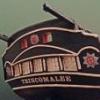HOLIDAY DONATION DRIVE - SUPPORT MSW - DO YOUR PART TO KEEP THIS GREAT FORUM GOING! (83 donations so far out of 49,000 members - C'mon guys!)
×
-
Posts
546 -
Joined
-
Last visited
Community Answers
-
Morgan's post in HMS Victory Steam Trunk was marked as the answer
I think you are describing the steam ducting that sat above the stove and transmitted the fumes etc. to the open deck via a grating.
It was metallic - tin or zinc from memory. Probably whitewashed like the interior hull sides.
Gary
-
Morgan's post in Main and Fore Preventor Stay was marked as the answer
There is circumstantial evidence that Victory carried crows feet at Trafalgar.
The painter Clarkson Stanfield when preparing his ‘Trafalgar’ painting produced a first draft for comment. The commentators in question were Trafalgar veterans including Victory’s captain Hardy. This initial draught showed no crows feet, but the final version included them. This obvious change suggests that this was a correction made on input from those veterans and points to a strong possibility of Victory having them fitted at Trafalgar.
Gary
-
Morgan's post in Shot Garlands was marked as the answer
Definitely bowl shaped sockets, below is a free standing version recovered from the wreck of HMS St. George which sank I think in 1811, you can see the slight scalloping.
Gary
-
Morgan's post in Query for Knowledge: Elm (Tree) Pumps? was marked as the answer
Hi Rick,
Elm Tree Pumps, also known as the common or brake pump were multifunctional. In a ship with chain pumps the Elm Tree Pump served to bring fresh seawater up for washing the decks and feeding the condenser on the stove. They could provide water for fire fighting on deck but they were only a lift pump and not a pressurised pump so couldn’t be directed at a fire as there was no head of water (ships had separate fire engines / pumps that could generate pressure and be directed at sails etc.)
Initially the pump casing was open directly to the sea through the ships bottom, but in the late 18th Century they were brought inboard and a system of indirect pipe work via valves and stop cocks could let sea water in to the cistern around the mainmast and the foot of the pump was now inside the ship within the cistern to lift the water.
In smaller ships without chain pumps the elm tree pump was the primary means of clearing water from the hold.
They are called Elm Tree Pumps as it was the bored trunk of an elm tree that was used for the pump casing.
Gary
-
Morgan's post in Thinking things through: Victorys bobstays was marked as the answer
Daniel,
The only one with any provenance is the 1805 model. The present day ship is a chimera of designs and times (or designs out of time!), and the Longridge example - whatever it is, is appears to be no better.
Like you I think the 1805 Model is Boyne / Union, a 98-Gun half sister to Victory, but that is irrelevant to your query, the rigging points are applicable whether a frigate or first rate, si I would follow what the model offers.
Gary
-
Morgan's post in which mini wood lathe is best? was marked as the answer
Hi Benjamin,
Perhaps think about what your immediate needs are for the next few models you intend to build, and use this to decide the size and complexity of lathe you need, narrow down your requirements. If you only intend turning cannon in the near future for example you can get away with a very small metal working lathe, if you want to turn masts and spars then you will need something with a longer bed.
Consider a phased approach and trading up to a larger lathe as your skills develop, this way you could buy a second hand lathe to get you started, which will have more features than a brand new lathe for a similar price.
I am sure if you can elaborate on what size and type of fittings you want to make you will get more specific pointers from knowledgeable forum members.
Gary
-
Morgan's post in Chart Cabinets On The Victory was marked as the answer
They are flag lockers and would have had a canvas front.
Gary


